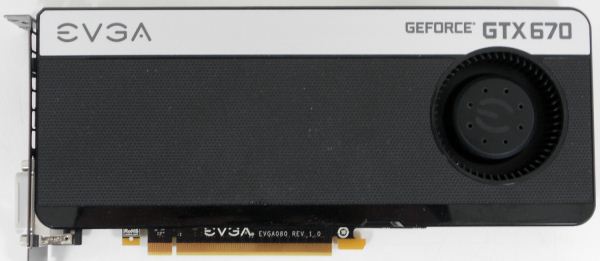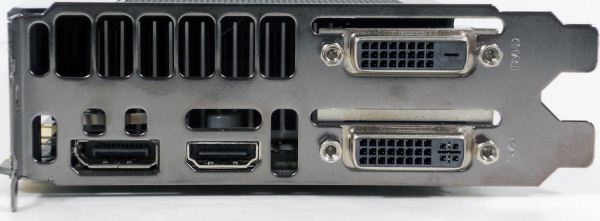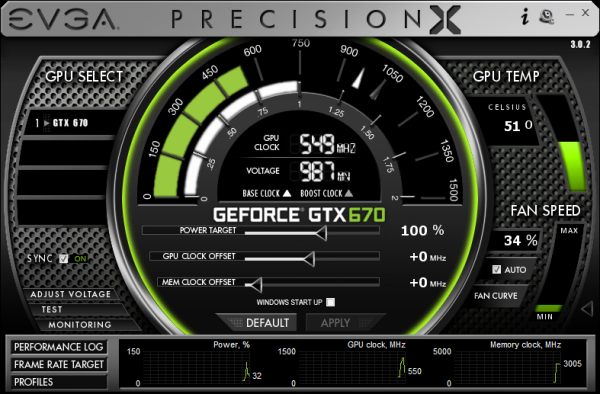NVIDIA GeForce GTX 670 Review Feat. EVGA: Bringing GK104 Down To $400
by Ryan Smith on May 10, 2012 9:00 AM ESTMeet The EVGA GeForce GTX 670 Superclocked
Our second card of the day is EVGA’s GeForce GTX 670 Superclocked, which in EVGA’s hierarchy is their first tier of factory overclocked cards. EVGA is binning GTX 670s and in turn promoting some of them to this tier, which means the GTX 670 Superclocked are equipped with generally better performing chips than the average reference card.
| GeForce GTX 670 Partner Card Specification Comparison | ||||
| EVGA GeForce GTX 670 Superclocked | GeForce GTX 670 (Ref) | |||
| CUDA Cores | 1344 | 1344 | ||
| Texture Units | 112 | 112 | ||
| ROPs | 32 | 32 | ||
| Base Clock | 967MHz | 915MHz | ||
| Boost Clock | 1046MHz | 980MHz | ||
| Memory Clock | 6210MHz | 6008MHz | ||
| Memory Bus Width | 256-bit | 256-bit | ||
| Frame Buffer | 2GB | 2GB | ||
| TDP | 170W | 170W | ||
| Manufacturing Process | TSMC 28nm | TSMC 28nm | ||
| Width | Double Slot | Double Slot | ||
| Length | 9.5" | 9.5" | ||
| Warranty | 3 Years | N/A | ||
| Price Point | $419 | $399 | ||
For the GTX 670 SC, EVGA has given both the core clock and memory clock a moderate boost. The core clock has been increased by 52MHz (6%) to 967MHz base and 66MHz (7%) boost to 1046MHz. Meanwhile the memory clock has been increased by 202MHz (3%) to 6210MHz.
Other than the clockspeed changes, the GTX 670 SC is an almost-reference card utilizing a reference PCB with a slightly modified cooler. EVGA is fabricating their own shroud, but they’ve copied NVIDIA’s reference shroud down to almost the last detail. The only functional difference is that the diameter of the fan intake is about 5mm less, otherwise the only difference is that EVGA has detailed it differently than NVIDIA and used some rounded corners in place of square corners.
The only other change you’ll notice is that EVGA is using their own high flow bracket in place of NVIDIA’s bracket. The high flow bracket cuts away as much metal as possible, maximizing the area of the vents. Though based on our power and temperature readings, this doesn’t seem to have notably impacted the GTX 670 SC.
While we’re on the matter of customized cards and factory overclocks, it’s worth reiterating NVIDIA’s position on factory overclocked cards. Reference and semi-custom cards (that is, cards using the reference PCB) must adhere to NVIDIA’s power target limits. For GTX 670 this is a 141W power target, with a maximum power target of 122% (170W). Fully custom cards with better power delivery circuitry can go higher, but not semi-custom cards. As a result the flexibility in building semi-custom cards comes down to binning. EVGA can bin better chips and use them in cards such as the Superclocked – such as our sample which can go 17 boost bins over the base clock versus 13 bins for our reference GTX 670 – but at the end of the day for stock performance they’re at the mercy of what can be accomplished within 141W/170W.
In any case, as the card is otherwise a reference GTX 670 EVGA is relying on the combination of their factory overclock, their toolset, and their strong reputation for support to carry the card. EVGA has priced the card at $419, $20 over the GTX 670 MSRP, in-line with other factory overclocked cards.
On the subject of pricing and warranties, since this is the first EVGA card we’ve reviewed since April 1st, this is a good time to go over the recent warranty changes EVGA has made.
Starting April 1st, EVGA has implemented what they’re calling their new Global Warranty Policy. Starting July 1st, 2011 (the policy is being backdated), all new EVGA cards ship with at least a 3 year warranty. And for the GTX 600 series specifically, so far EVGA has only offered models with a 3 year warranty in North America, which simplifies their product lineup.
To complement the 3 year warranty and replace the lack of longer term warranties, EVGA is now directly selling 2 and 7 year warranty extensions, for a total of 5 and 10 years respectively. So instead of buying a card with a 3 year warranty or a longer warranty, you’ll simply buy the 3 year card and then buy a warranty extension to go with it. However the extended warranty requires that the card be registered and the warranty purchased within 30 days.
The second change is that the base 3 year warranty no longer requires product registration. EVGA has other ways to entice buyers into registering, but they’ll now honor all applicable cards for 3 years regardless of the registration status. At the same time the base 3 year warranty is now a per-product warranty (e.g. a transferable warranty) rather than per-user warranty, so the base warranty will transfer to 2nd hand buyers. The extended warranties however will not.
The third change is how EVGA is actually going to handle the warranty process. First and foremost, EVGA is now allowing cards to be sent to the nearest EVGA RMA office rather than the office for the region the card was purchased from. For example a buyer moving from Europe to North America can send the card to EVGA’s North American offices rather than sending it overseas.
Finally, EVGA is now doing free cross shipping, alongside their existing Advanced RMA program. EVGA will now cross-ship replacement cards for free to buyers. The buyer meanwhile is responsible for paying to ship the faulty card back and putting up collateral on the new card until EVGA receives the old card.
There’s also one quick change to the step-up program that will impact some customers. With the move to purchasing extended warranties, the step-up program is only available to customers who either purchase an extended warranty or purchase an older generation card that comes with a lifetime warranty. Step-up is not available to cards with only the base 3 year warranty.
Moving on, along with EVGA’s new warranty EVGA is bundling the latest version of their GPU utilities, Precision X and OC Scanner X.
Precision X, as we touched upon quickly in our GTX 680 review, is the latest iteration of EVGA’s Precision overclocking & monitoring utility. It’s still based on RivaTuner and along with adding support for the GTX 600 series features (power targets, framerate caps, etc), it also introduces a new UI. Functionality wise it’s still at the top of the pack along with the similarly RivaTuner powered MSI Afterburner. Personally I’m not a fan of the new UI – circular UIs and sliders aren’t particularly easy to read – but it gets the job done.
OC Scanner X has also received a facelift and functionality upgrade of its own. Along with its basic FurMark-ish stress testing and error checking, it now also offers a basic CPU stress test and GPU benchmark.



















414 Comments
View All Comments
snakefist - Saturday, May 12, 2012 - link
"...that the 365mm die is over 43% larger than the 300mm die."die size is in mm2 and NOT in diameter (mm). do your math again... and gtx680 die is 294mm2... to your pleasure, it increases the size difference... the real one, not the 43% you came out with - somehow
now, these were two of the things you learned from me :)
reading more, instead writing would help you, as well anger-management i suggested earlier :)
CeriseCogburn - Saturday, May 12, 2012 - link
Why then I await your math calculation.I'll let you know now I'll be back after 3 seasons pass to give you time to prepare your answer.
It doesn't surprise me one iota the stupid amd fanboy even increased the nVidia core size for that always needed amd liar cheat, nor that praise for his sanity followed on unopposed except by yours truly. Sometimes letting a liar even have part of his lie and still proving him wrong is good enough.
No need however to correct my shorthand text concerning circular vs rectangular area, but as I imagine the stupidity you are surrounded with inside your own head you thought it a possibility, and it clearly indicates you didn't read the part of the thread discussed as well.
snakefist - Sunday, May 13, 2012 - link
you do realize that 300mm is about a length of an A4 page, don't you?i don't need to calculate anything, it's clearly that nvidia die is ~20% smaller than amd one...
on the other hand, unlike you, i know how to calculate, maybe that explains why your mistake was so obvious to me...
"stupidity you are surrounded with" - sadly, true - but i'm only surrounded by you... but than again, it's the only reason i even talk to you - it's kinda fun because i don't get angry at all (quite the opposite), and you're spilling poison - seriously, how long you spent on writing that 1,000,000 comments about nvidia being better?
i've spent about half an hour talking to you in total, and for own amusement purposes
CeriseCogburn - Sunday, May 13, 2012 - link
That's over 22%snakefist - Friday, May 18, 2012 - link
i did right to come back here, more laughter!YOU are correcting ME?
what now, i should calculate 22% decimals, and correct you?
man, i KNOW math, you DON'T. otherwise, it would strike you immediately for 2x mistake you made in post (lets assume square was a type, thought i'm not quite sure).
now ~20% means ABOUT and it is that way because it applies in similar fashion to both bigger-than and less-than scenarios, things you wouldn't of course know anything about
but then again, i proclaim FULL VICTORY for you on math issue, you were right all along, even when you wrote 43, 46 or whatever you did in the first place (without "~" which means "approximate" for you, and you didn't used it, meaning it was exactly 43 (or 46, whatever))
you're mathematical genius and i envy you a great deal on vast amount of hardware knowledge you have. happy?
snakefist - Friday, May 18, 2012 - link
oh, "typo", not "type"CeriseCogburn - Friday, May 11, 2012 - link
Here we get it again, since nVidia's 670, the card under review did better than expected, something is wrong..." For reasons that aren’t entirely clear Batman isn’t as shader performance bottlenecked as we would have expected, leading to it doing so well compared to the GTX 680 here. "
Something is wrong, Batman is not so shader bottlenecked, and since it's so easy, the "harvested"(defective according to the reviewer) 670 core can do well.
What happened to the 570 attack this time ? Nothing, since.the 570 beats the 7870 at 2560 here, but since we can't cut the 570 down, we won't mention it.
Instead of mentioning the 670OC beats the amd flagship at the highest resolution 5760x1200, the reviewer has to play that down, so only mentions the 670OC "coming to parity" with the 6970 at middle resolution, 2560, after the STOCK 670 beats the amd 7970 at the low 1920 resolution !
ROFL - once again the analysis favors and coddles amd.
" EVGA’s overclock, even if it’s once again only around 3%, is just enough to close that gap and to bring the GTX 670 to parity with the GTX 680 and the 7970. "
No, the OC shows the 670 beating the 7970 at the highest triple screen 5760 resolution, and the STOCK 670 BEATS THE 7970 at the lowest resolution, 1920... so somehow "that's parity".
How the heck does that work ?
Do we hear once in all this game page commentary what the 7950 at the very same $399 as the 670 price is doing ?
I don't think we do.
Where is that ?
Instead of attacking the 7950 that is currently the same price as the 670, we get the reviewer over and over again attacking the GTX570 that he notes nVidia mentioned to him, making him think the GTX570 will be part of nVidia's line up for some time he states. Not once did he point out how well the GTX570 did against the amd competition.
Not once do swe hear how the 7950 costs the same but loses, loses loses. Nothing specific.
Instead we hear 670 vs 680 or attack the 570, or make excuses for the 7970 or call it inexplicable..
medi01 - Friday, May 11, 2012 - link
Can someone ban this zealot please?sausagefingers - Friday, May 11, 2012 - link
+1CeriseCogburn - Friday, May 11, 2012 - link
You can blame silverblue who begged for proof about the bias in these articles. Go call your buddy so you can both smack talk about me, or heck post it here openly like you do, why not you're innocent no matter what you do as an amd fanboy, right ?